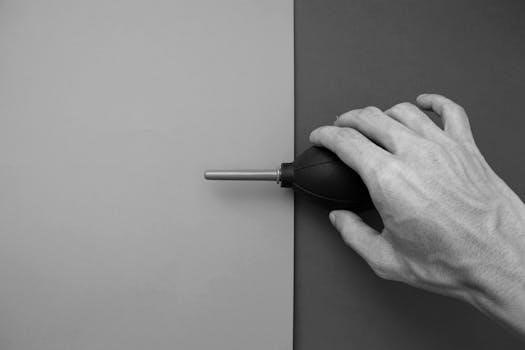CAV injector pumps are a vital part of diesel fuel systems, known for their robust design․ These pumps, often found in vintage machinery, require precise service․ Numerous manuals exist, covering service, parts, and data for various CAV models․ Understanding these systems is key for effective maintenance․
Overview of CAV Fuel Injection Systems
CAV fuel injection systems, a legacy of Lucas CAV, are integral to many diesel engines․ These systems utilize distributor-type injection pumps, notably the DPA and DPS models․ The systems are designed to deliver fuel with precision, ensuring efficient combustion․ A key component is the rotary injection pump, which features a central rotating member for pumping and distribution․ Fuel is drawn from the tank, filtered, and then pressurized by the pump․ The system includes air bleed points for proper operation, often requiring specific procedures during service․ Manuals for these systems detail components like feed pumps and injectors, offering vital information for maintenance and repair․ The design emphasizes cleanliness, highlighting the necessity of a clean environment when performing any work․ These systems, while robust, require careful handling to maintain their functionality, often relying on specialized service depots for complex readjustments or repairs․

Understanding CAV DPA Pumps
CAV DPA pumps are a common type of distributor injection pump․ These pumps are used in various applications across many brands․ DPA models have specific service data and are featured in multiple service bulletins and manuals․
CAV DPA Pump Applications Across Different Brands
CAV DPA pumps have a widespread application across numerous agricultural and industrial brands, showcasing their versatility and reliability․ These pumps are frequently found in Massey Ferguson tractors, often paired with Perkins engines like the A 3․152․ Brands such as Lindner and Fiat Allis also incorporate CAV DPA pumps into their machinery․ Furthermore, these pumps are utilized in New Holland equipment, highlighting their presence across diverse agricultural settings․ The DPA pump’s adaptability extends to industrial applications, seen in equipment from brands like Sambron and JCB․ Oliver and IHC also feature these pumps in some of their models․ The widespread use of CAV DPA pumps is a testament to their robust engineering and reliable performance․ This also means that understanding specific applications is crucial when consulting repair manuals, as pump specifications can vary from brand to brand and model to model․ The diverse applications underscore the necessity for accurate identification and relevant service information․
Common CAV DPA Pump Models
Several CAV DPA pump models are widely recognized for their specific applications and design characteristics․ The 3230F series, including models like 3230F030, 3230F180, and 3230F450, is frequently used in older Massey Ferguson tractors with Perkins A 3․152 engines․ The 3233F series, encompassing models such as 3233F180 and 3233F450, also has a strong presence in various agricultural equipment from brands like Fiat and IHC․ Furthermore, the 3241F series, including the 3241F102 and 3241F800 models, is utilized across diverse applications, such as in JCB machinery․ Models within the 3249F series, like 3249F010 and 3249F660, are found in equipment from brands such as Fiat and White․ The 3342F series, including the 3342F020 and 3342F610, is used in applications from New Holland and Iveco․ These models highlight the range of CAV DPA pumps and the importance of identifying the specific model when consulting manuals or performing maintenance․

Service and Repair of CAV Pumps
Servicing CAV pumps requires attention to detail, cleanliness, and proper procedures․ Manuals offer guidance for disassembly and reassembly, emphasizing the importance of clean parts․ Accredited service depots are recommended for complex readjustments and repairs․
Locating CAV Manuals and Service Information
Finding the right CAV manual for your specific injector pump model is crucial for effective maintenance and repair․ A wealth of resources exists online, including extensive archives of vintage manuals, some of which cover not only CAV but also Bosch and Simms systems․ These materials often include service manuals, parts manuals, and crucial service data․ Websites dedicated to diesel injection systems frequently host downloadable PDF versions of these manuals, making them easily accessible․
Look for specialized forums and online communities where enthusiasts and professionals share their knowledge and resources, sometimes providing direct links to specific CAV documentation․ Furthermore, some parts suppliers and tractor maintenance companies offer manuals as part of their product offerings, either as physical copies or digital downloads․ Remember to check for date codes within the manual to ensure it aligns with your pump’s specific model and version․ Accessing this information helps ensure accurate and safe repairs of your CAV injection pump․
Step-by-step Guide to CAV Fuel Injection Pump Disassembly and Reassembly
Disassembling a CAV fuel injection pump requires meticulous attention to detail and a thorough understanding of its components․ Begin by ensuring the pump and surrounding area are completely clean to prevent contamination․ A step-by-step approach is essential, often starting with the removal of external components like the fuel lines and linkages․ As you proceed, carefully note the position and orientation of each part to aid in reassembly․
The internal workings of the pump, including the pumping and distributing rotor, should be handled with extreme care․ When reassembling, ensure all parts are entirely clean and properly aligned, paying close attention to seals and gaskets․ Proper torque specifications must be followed to avoid damage․ Consult your specific CAV manual for detailed instructions and diagrams, as models can vary significantly․ After reassembly, a complete readjustment may be required by an accredited service depot to ensure proper function and calibration of your fuel system․
Essential Safety Tips for Handling the Fuel System
Working with any fuel system, especially one involving diesel and high-pressure injection pumps like those from CAV, demands strict adherence to safety protocols․ Always begin by disconnecting the battery to prevent accidental ignition or electrical shorts․ Cleanliness is paramount; ensure the work area and all tools are free from dirt and contaminants before starting any repairs․
When handling fuel lines and components, be aware of the risk of fuel spillage and potential fire hazards․ Wear appropriate protective gear, including gloves and eye protection, to avoid contact with diesel fuel․ Never attempt to service a fuel injection pump while the engine is running or hot․ Always work in a well-ventilated area to avoid inhaling fuel vapors․ Consult your CAV manual for specific safety warnings related to your pump model․ If you are not comfortable with the procedure seek professional help from an accredited service depot․

Maintenance and Troubleshooting
Maintaining CAV injection pumps involves regular cleaning and checks․ Common issues include fuel leaks or poor engine performance․ Proper troubleshooting, using available manuals, is crucial for resolving any problems; Access to correct data is important․
Cleaning and Maintenance of CAV Injection Pumps
Regular cleaning and maintenance are essential for the longevity and efficient operation of CAV injection pumps․ Cleanliness is paramount when servicing any part of the diesel fuel system, particularly the injection pump․ Before performing any maintenance, thoroughly clean the pump and the surrounding area on the tractor or equipment․ This prevents dirt and debris from entering the sensitive components of the fuel system during disassembly and reassembly․ For optimal performance, it is advised to periodically inspect all seals and gaskets for wear or damage, replacing them as needed to prevent leaks․ Using appropriate cleaning solvents and tools will help remove any accumulated grime or contaminants that can impede the pump’s functionality․ Furthermore, adhering to the procedures outlined in the CAV service manuals will ensure that the cleaning and maintenance processes are carried out correctly, preventing any potential issues down the line․ Always refer to the specific manual for your pump model for detailed instructions and recommended practices․ Proper upkeep will greatly contribute to the reliable performance of your CAV injection pump․
Troubleshooting Common Issues in CAV Systems
Identifying and addressing common issues in CAV fuel systems is crucial for maintaining optimal performance․ Problems such as fuel leaks, erratic engine behavior, or difficulty starting often point to underlying issues within the injection pump or its related components․ Troubleshooting requires a systematic approach, often involving checking fuel lines, filters, and the pump itself for blockages or wear․ Air in the fuel system can also cause significant problems, so bleeding the system according to the manufacturer’s guidelines is a necessary first step․ If the issue persists, inspecting the pump’s internal components, such as the rotor and plungers, for damage might be necessary, following the detailed instructions in the service manuals․ A sudden loss of power or excessive smoke could also indicate problems with the injection timing or delivery, which would require further investigation․ Utilizing the diagnostic information within the CAV manuals can provide valuable guidance for resolving these common issues and ensuring the reliable operation of the system․

Additional Resources
For further assistance, locate CAV spare parts and repair kits through specialized suppliers․ Service depots offer expert help․ Many online resources provide manuals and support for these systems․ Accessing these materials can aid in effective maintenance․
Where to Find CAV Spare Parts and Repair Kits
Sourcing the correct spare parts and repair kits for CAV injector pumps is crucial for maintaining their performance and longevity․ Several avenues exist for finding these essential components․ Online retailers specializing in vintage and classic machinery parts often stock a wide range of CAV components․ These suppliers frequently offer detailed catalogs and specifications, making it easier to identify the correct parts for your specific pump model․ Additionally, dedicated diesel fuel injection specialists may carry both new and refurbished CAV parts․ These specialists can also provide expert advice on the compatibility and suitability of parts for various applications․ It’s always recommended to verify the authenticity and quality of parts from any supplier to ensure proper function and durability․ Some online archives also contain part numbers and detailed information, which can be invaluable when searching for specific components․ These resources may also offer cross-reference data to help find compatible parts․ Seeking out reputable suppliers with experience in CAV systems is key for a successful repair; Furthermore, consider reaching out to online forums and communities where CAV owners and enthusiasts often share information regarding spare parts availability and reliable suppliers․ This approach can lead to finding both common and harder-to-source components․
Specialized CAV Service Depots and Support
For complex repairs and overhauls of CAV injector pumps, specialized service depots offer invaluable expertise and support․ These depots often employ technicians with extensive training and experience in working with various CAV models․ They possess the necessary tools and diagnostic equipment to accurately assess and address issues with CAV pumps․ Such specialized facilities are equipped to handle complete pump rebuilds, ensuring components are correctly reassembled and calibrated․ These depots frequently maintain a stock of genuine CAV parts, ensuring high-quality repairs․ Furthermore, many of these service centers can offer advice on best practices for maintenance and troubleshooting․ When seeking out a service depot, it is important to verify their experience specifically with CAV pumps․ Some depots might focus on certain types of injection systems, so it’s key to find one familiar with your specific pump model․ These specialized centers often provide warranties on their work, offering peace of mind․ Support can also be found through online communities and forums where CAV owners share their experiences with different service depots․ Reaching out to such networks can provide insight into the reputation and reliability of different service options․ Consider utilizing online resources to find CAV service centers located near you or those that offer shipping services for remote repairs․
